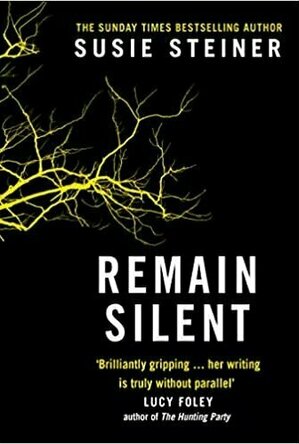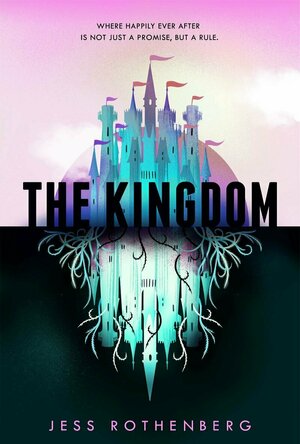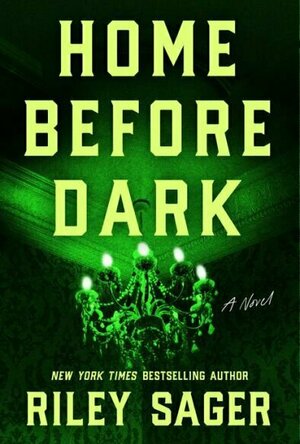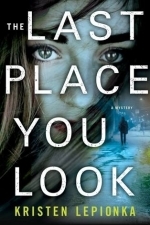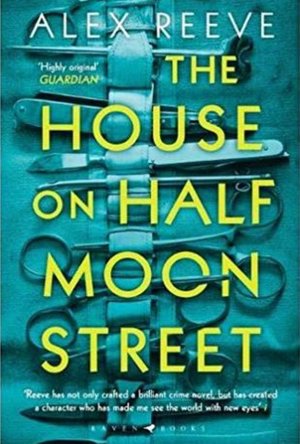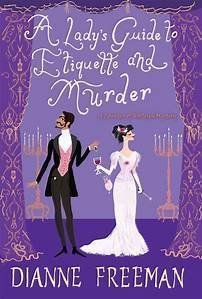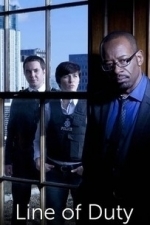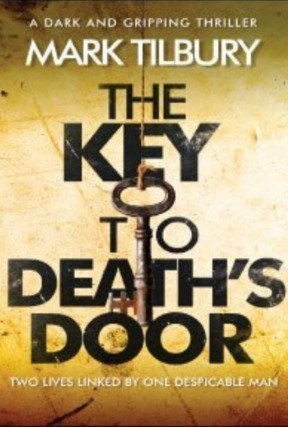Search
Search results
Kristy H (1252 KP) rated Remain Silent in Books
Jun 11, 2020
In the third book in Steiner's Manon Bradshaw series, we find Manon at work part-time in cold cases, leaving her "time" to raise her toddler, Teddy, and teenage son, Fly. She's adjusting to domestic living with Mark and all the bliss that comes with it: who will take out the garbage, pick up the kids, cook dinner, and more. Then Teddy and Manon take a walk to the park and discover a body: a Lithuanian immigrant named Lukas hanging from a tree, a note attached to his body. Manon's annoying and perhaps clueless boss assigns her to lead the case--with her faithful partner Davy Walker--and Manon is back, attempting to juggle work, motherhood, and what could be a very dangerous murder case.
I love Manon and this was yet another well-written mystery from Steiner. The introduction to this book features one of the most amazing, realistic, and yes, depressing, ruminations on marriage, life, and death that I may have ever read. In fact, Steiner so perfectly captures real life, especially juggling being a working mom. I love that she doesn't shy away from how hard Manon finds parenting, or gloss over the difficulties of marriage. Once or twice I might have found these tirades a bit tiresome (back to the case, I say!), but overall, it's refreshing to find a book that tells it like it is.
Speaking of, this is such a timely read, focusing on immigration, racism, and the overall hatred of "otherness" that seems to permeate the world right now. The central plot focuses on the infusion of immigrants, particularly Eastern Europeans, into England. The story told is a heartbreaking one of anger and loss. Steiner deftly weaves a tale from multiple points of view and time periods--we hear not only from Manon and Davy, but Lukas' friend Matis, who spearheads the pair's immigration from Lithuania, only for them to find themselves basically prisoners. They are indebted to the man who brought them over, trapped in a smelly workhouse, and forced to do menial labor to pay off their "debt." With Lukas dead, the story leading up to his death unfolds, and it's absolutely riveting and heartbreaking. Steiner handles the sensitive issues surrounding immigration and racism wonderfully, crafting a well-done mystery that still gives this topic its due.
"'Why do they hate us so much?'"
Overall, I cannot recommend this book (4.5 stars) or this series enough. I have followed Steiner on social media for years and was devastated to learn she was diagnosed with a brain tumor after submitting this book. My heart goes out to her and her recovery.
I love Manon and this was yet another well-written mystery from Steiner. The introduction to this book features one of the most amazing, realistic, and yes, depressing, ruminations on marriage, life, and death that I may have ever read. In fact, Steiner so perfectly captures real life, especially juggling being a working mom. I love that she doesn't shy away from how hard Manon finds parenting, or gloss over the difficulties of marriage. Once or twice I might have found these tirades a bit tiresome (back to the case, I say!), but overall, it's refreshing to find a book that tells it like it is.
Speaking of, this is such a timely read, focusing on immigration, racism, and the overall hatred of "otherness" that seems to permeate the world right now. The central plot focuses on the infusion of immigrants, particularly Eastern Europeans, into England. The story told is a heartbreaking one of anger and loss. Steiner deftly weaves a tale from multiple points of view and time periods--we hear not only from Manon and Davy, but Lukas' friend Matis, who spearheads the pair's immigration from Lithuania, only for them to find themselves basically prisoners. They are indebted to the man who brought them over, trapped in a smelly workhouse, and forced to do menial labor to pay off their "debt." With Lukas dead, the story leading up to his death unfolds, and it's absolutely riveting and heartbreaking. Steiner handles the sensitive issues surrounding immigration and racism wonderfully, crafting a well-done mystery that still gives this topic its due.
"'Why do they hate us so much?'"
Overall, I cannot recommend this book (4.5 stars) or this series enough. I have followed Steiner on social media for years and was devastated to learn she was diagnosed with a brain tumor after submitting this book. My heart goes out to her and her recovery.
Lottie disney bookworm (1056 KP) rated The Kingdom in Books
Oct 17, 2019
“Where Happily Ever After is not just a promise, but a rule”
I mean with a tag line like that you can’t not be drawn in by this book! If that doesn’t grab you then the gorgeous cover art will.
Once you get past the wonderful aesthetics; the ‘Disney x Westworld x Big Little Lies’ reality that Jess Rothenberg conjures is sure to captivate you. Rothenberg manages to describe her Kingdom in such minute detail without it seeming contrite: the brazen references to meet and greets, monorails and “the park” are like catnip to a Disney geek like myself; whilst the proclamation from the outset that a crime has occurred appeals to the (slightly) more mature side of this 32 year old bookworm.
The Kingdom is a magical place where dreams come true: or is it? The star attractions: the princesses; are beautiful, perfect, always say the right thing and…are Artificial Intelligence. Their sophisticated technology, wireless signals and encyclopaedic knowledge ensure the princesses are as perfect as possible but it quickly becomes apparent that the princesses are, in fact, prisoners: constantly under surveillance, tracked by GPS implants in their wrists and strapped to their beds at “downtime”.
Ana is our princess and storyteller, opening her world to the reader and introducing us to her “sisters”, “mother” and “father” as well as those who have slightly less favourable views towards the AI, or Fantasists as they are known. There is no doubt that Ana is advanced in comparison to other Fantasists that we meet: she is aware of the park’s wireless blind spots and admits she becomes weary of some songs, unruly children and fathers with wandering eyes. Ironically, Ana is a profoundly human character with whom the reader immediately allies themselves with. Despite clearly being a suspect in the ongoing murder trial, I can’t see any reader convicting Ana. On the contrary, it is a real testament to Jess Rothenberg’s writing that the reader identifies with the Fantasists over and above every human character in her novel. Even Owen, the main human character, is never entirely trustworthy and does not reveal his intentions readily.
The format of The Kingdom is unlike anything else out there at the moment, in my opinion. The mix of prose, advertisements, interviews, trial transcripts and even apps allow our Fantasist to tell her story but also allows the reader to meet personnel and witness events that Ana would never see. This aspect is crucial to the murder mystery vibe of The Kingdom and Rothenberg leaves the reader guessing right to the very end and begging for a sequel.
Rothenberg’s kingdom is quick to show its murkier, thornier side. Those who question their surroundings are made an example of; nature is manipulated for entertainment and nothing is what it seems. If you haven’t guessed by now, I absolutely adored this book. It had me gripped from beginning to end. If you read one Disney book this year- read this one!
I mean with a tag line like that you can’t not be drawn in by this book! If that doesn’t grab you then the gorgeous cover art will.
Once you get past the wonderful aesthetics; the ‘Disney x Westworld x Big Little Lies’ reality that Jess Rothenberg conjures is sure to captivate you. Rothenberg manages to describe her Kingdom in such minute detail without it seeming contrite: the brazen references to meet and greets, monorails and “the park” are like catnip to a Disney geek like myself; whilst the proclamation from the outset that a crime has occurred appeals to the (slightly) more mature side of this 32 year old bookworm.
The Kingdom is a magical place where dreams come true: or is it? The star attractions: the princesses; are beautiful, perfect, always say the right thing and…are Artificial Intelligence. Their sophisticated technology, wireless signals and encyclopaedic knowledge ensure the princesses are as perfect as possible but it quickly becomes apparent that the princesses are, in fact, prisoners: constantly under surveillance, tracked by GPS implants in their wrists and strapped to their beds at “downtime”.
Ana is our princess and storyteller, opening her world to the reader and introducing us to her “sisters”, “mother” and “father” as well as those who have slightly less favourable views towards the AI, or Fantasists as they are known. There is no doubt that Ana is advanced in comparison to other Fantasists that we meet: she is aware of the park’s wireless blind spots and admits she becomes weary of some songs, unruly children and fathers with wandering eyes. Ironically, Ana is a profoundly human character with whom the reader immediately allies themselves with. Despite clearly being a suspect in the ongoing murder trial, I can’t see any reader convicting Ana. On the contrary, it is a real testament to Jess Rothenberg’s writing that the reader identifies with the Fantasists over and above every human character in her novel. Even Owen, the main human character, is never entirely trustworthy and does not reveal his intentions readily.
The format of The Kingdom is unlike anything else out there at the moment, in my opinion. The mix of prose, advertisements, interviews, trial transcripts and even apps allow our Fantasist to tell her story but also allows the reader to meet personnel and witness events that Ana would never see. This aspect is crucial to the murder mystery vibe of The Kingdom and Rothenberg leaves the reader guessing right to the very end and begging for a sequel.
Rothenberg’s kingdom is quick to show its murkier, thornier side. Those who question their surroundings are made an example of; nature is manipulated for entertainment and nothing is what it seems. If you haven’t guessed by now, I absolutely adored this book. It had me gripped from beginning to end. If you read one Disney book this year- read this one!
Heather Cranmer (2721 KP) rated Home Before Dark in Books
Mar 26, 2021
I've read all of Riley Sager's books so far, so when I saw that he had released Home Before Dark, I knew I had to read that book too. While it wasn't Sager's best work, I still enjoyed reading it.
After Maggie's father dies, she inherits Baneberry Hall, a place Maggie and her family escaped many years ago when she was 5 years old. Maggie's father has written a best seller about their stay in Baneberry Hall, but Maggie doesn't believe it. However, when she returns to Baneberry Hall, strange things start happening...things that Maggie's father wrote about in the book. Could it be ghosts or is Maggie just imagining things?
The plot of Home Before Dark is certainly intriguing. However, the first three quarters of the book were a bit too slow of a pace for my liking. I only kept reading because I was hoping the book would get better. My patience was rewarded in the last quarter of Home Before Dark when the pacing sped up, and I couldn't put this book down. I kept trying to figure out if Maggie was experiencing a haunting and who the ghosts could be. Home Before Dark has a great plot twist (that I didn't see coming). Even its plot twist had a plot twist which was exciting! I also thought it was pretty cool how Home Before Dark reads as two books since we get to read the book Maggie's father wrote as well as what is happening to Maggie in the here and now. Both stories flow together smoothly. At the end of the book, my jaw was left on the floor after what all had happened. All loose ends are tied up nicely, and there are no cliffhangers.
I enjoyed the characters in Home Before Dark. Each character was fleshed out well and had enough backstory where it was easy to picture each individual one. I enjoyed reading about Maggie. Her skepticism was a nice touch, and her thought process was interesting. I could totally relate with her wanting to know if her father's book was actually true and wanting to find out the mystery of why her family actually left Banebury Hall when she was 5 without taking any belongings. I also loved reading about Maggie's father and her mother Jess through Maggie's father's book. (I felt like their story was a bit more interesting than Maggie's.) I get why they did what they did many years ago even if I didn't agree with what they did.
Trigger warnings for Home Before Dark include violence, death, murder, talks of suicide, attempted murder, some profanity, and the occult.
Although Home Before Dark starts out slow, it definitely makes up for it towards the end. With an intriguing plot and well written characters, Home Before Dark is a book worth reading. I would recommend Home Before Dark by Riley Sager to those aged 16+ who are after a creepy thrilling read.
After Maggie's father dies, she inherits Baneberry Hall, a place Maggie and her family escaped many years ago when she was 5 years old. Maggie's father has written a best seller about their stay in Baneberry Hall, but Maggie doesn't believe it. However, when she returns to Baneberry Hall, strange things start happening...things that Maggie's father wrote about in the book. Could it be ghosts or is Maggie just imagining things?
The plot of Home Before Dark is certainly intriguing. However, the first three quarters of the book were a bit too slow of a pace for my liking. I only kept reading because I was hoping the book would get better. My patience was rewarded in the last quarter of Home Before Dark when the pacing sped up, and I couldn't put this book down. I kept trying to figure out if Maggie was experiencing a haunting and who the ghosts could be. Home Before Dark has a great plot twist (that I didn't see coming). Even its plot twist had a plot twist which was exciting! I also thought it was pretty cool how Home Before Dark reads as two books since we get to read the book Maggie's father wrote as well as what is happening to Maggie in the here and now. Both stories flow together smoothly. At the end of the book, my jaw was left on the floor after what all had happened. All loose ends are tied up nicely, and there are no cliffhangers.
I enjoyed the characters in Home Before Dark. Each character was fleshed out well and had enough backstory where it was easy to picture each individual one. I enjoyed reading about Maggie. Her skepticism was a nice touch, and her thought process was interesting. I could totally relate with her wanting to know if her father's book was actually true and wanting to find out the mystery of why her family actually left Banebury Hall when she was 5 without taking any belongings. I also loved reading about Maggie's father and her mother Jess through Maggie's father's book. (I felt like their story was a bit more interesting than Maggie's.) I get why they did what they did many years ago even if I didn't agree with what they did.
Trigger warnings for Home Before Dark include violence, death, murder, talks of suicide, attempted murder, some profanity, and the occult.
Although Home Before Dark starts out slow, it definitely makes up for it towards the end. With an intriguing plot and well written characters, Home Before Dark is a book worth reading. I would recommend Home Before Dark by Riley Sager to those aged 16+ who are after a creepy thrilling read.
Lottie disney bookworm (1056 KP) rated The Kingdom in Books
Sep 20, 2020
“Where Happily Ever After is not just a promise, but a rule”
I mean with a tag line like that you can’t not be drawn in by this book! If that doesn’t grab you then the gorgeous cover art will.
Once you get past the wonderful aesthetics; the ‘Disney x Westworld x Big Little Lies’ reality that Jess Rothenberg conjures is sure to captivate you. Rothenberg manages to describe her Kingdom in such minute detail without it seeming contrite: the brazen references to meet and greets, monorails and “the park” are like catnip to a Disney geek like myself; whilst the proclamation from the outset that a crime has occurred appeals to the (slightly) more mature side of this 32 year old bookworm.
The Kingdom is a magical place where dreams come true: or is it? The star attractions: the princesses; are beautiful, perfect, always say the right thing and…are Artificial Intelligence. Their sophisticated technology, wireless signals and encyclopaedic knowledge ensure the princesses are as perfect as possible but it quickly becomes apparent that the princesses are, in fact, prisoners: constantly under surveillance, tracked by GPS implants in their wrists and strapped to their beds at “downtime”.
Ana is our princess and storyteller, opening her world to the reader and introducing us to her “sisters”, “mother” and “father” as well as those who have slightly less favourable views towards the AI, or Fantasists as they are known. There is no doubt that Ana is advanced in comparison to other Fantasists that we meet: she is aware of the park’s wireless blind spots and admits she becomes weary of some songs, unruly children and fathers with wandering eyes. Ironically, Ana is a profoundly human character with whom the reader immediately allies themselves with. Despite clearly being a suspect in the ongoing murder trial, I can’t see any reader convicting Ana. On the contrary, it is a real testament to Jess Rothenberg’s writing that the reader identifies with the Fantasists over and above every human character in her novel. Even Owen, the main human character, is never entirely trustworthy and does not reveal his intentions readily.
The format of The Kingdom is unlike anything else out there at the moment, in my opinion. The mix of prose, advertisements, interviews, trial transcripts and even apps allow our Fantasist to tell her story but also allows the reader to meet personnel and witness events that Ana would never see. This aspect is crucial to the murder mystery vibe of The Kingdom and Rothenberg leaves the reader guessing right to the very end and begging for a sequel.
Rothenberg’s kingdom is quick to show its murkier, thornier side. Those who question their surroundings are made an example of; nature is manipulated for entertainment and nothing is what it seems. If you haven’t guessed by now, I absolutely adored this book. It had me gripped from beginning to end. If you read one Disney book this year- read this one!
I mean with a tag line like that you can’t not be drawn in by this book! If that doesn’t grab you then the gorgeous cover art will.
Once you get past the wonderful aesthetics; the ‘Disney x Westworld x Big Little Lies’ reality that Jess Rothenberg conjures is sure to captivate you. Rothenberg manages to describe her Kingdom in such minute detail without it seeming contrite: the brazen references to meet and greets, monorails and “the park” are like catnip to a Disney geek like myself; whilst the proclamation from the outset that a crime has occurred appeals to the (slightly) more mature side of this 32 year old bookworm.
The Kingdom is a magical place where dreams come true: or is it? The star attractions: the princesses; are beautiful, perfect, always say the right thing and…are Artificial Intelligence. Their sophisticated technology, wireless signals and encyclopaedic knowledge ensure the princesses are as perfect as possible but it quickly becomes apparent that the princesses are, in fact, prisoners: constantly under surveillance, tracked by GPS implants in their wrists and strapped to their beds at “downtime”.
Ana is our princess and storyteller, opening her world to the reader and introducing us to her “sisters”, “mother” and “father” as well as those who have slightly less favourable views towards the AI, or Fantasists as they are known. There is no doubt that Ana is advanced in comparison to other Fantasists that we meet: she is aware of the park’s wireless blind spots and admits she becomes weary of some songs, unruly children and fathers with wandering eyes. Ironically, Ana is a profoundly human character with whom the reader immediately allies themselves with. Despite clearly being a suspect in the ongoing murder trial, I can’t see any reader convicting Ana. On the contrary, it is a real testament to Jess Rothenberg’s writing that the reader identifies with the Fantasists over and above every human character in her novel. Even Owen, the main human character, is never entirely trustworthy and does not reveal his intentions readily.
The format of The Kingdom is unlike anything else out there at the moment, in my opinion. The mix of prose, advertisements, interviews, trial transcripts and even apps allow our Fantasist to tell her story but also allows the reader to meet personnel and witness events that Ana would never see. This aspect is crucial to the murder mystery vibe of The Kingdom and Rothenberg leaves the reader guessing right to the very end and begging for a sequel.
Rothenberg’s kingdom is quick to show its murkier, thornier side. Those who question their surroundings are made an example of; nature is manipulated for entertainment and nothing is what it seems. If you haven’t guessed by now, I absolutely adored this book. It had me gripped from beginning to end. If you read one Disney book this year- read this one!
Kristy H (1252 KP) rated The Last Place You Look in Books
Dec 24, 2017
funny (2 more)
dark
sarcastic
Roxane Weary is good at finding things. She always has been. So when she's hired by Brad Stockton's sister, Danielle, to find Brad's teenage girlfriend, Sarah, she doesn't think it will be a difficult case. Danielle is convinced she spotted Sarah at a gas station--despite the fact she disappeared fifteen years ago. Meanwhile, Brad is in jail--set to soon be executed--for the brutal murder of Sarah's parents the night Sarah disappeared; the prosecution also alleged that Brad killed Sarah as well. Brad did not put up much of a fight in his defense, but Danielle refuses to give up. Roxane quickly becomes caught up in Sarah's story and finds ties between her disappearance and other girls in the seemingly idyllic town of Belmont-- as well as connections to cases worked by her father, a police officer.
This is just a great book. It's easy to read and funny, albeit dark and sad at times. Roxane's dark, sarcastic humor is perfect. She gives off a Kinsey Millhone type vibe, if Kinsey was a functioning alcoholic with major Daddy issues. She's a complicated character (a complicated, real, female character - so refreshing!). She's bisexual (so wonderful to see reflected realistically in a novel). The other characters are well-formed and range from awful to sweet, but they support Roxane and the story perfectly.
As for the plot, it draws you immediately and keeps you constantly guessing, wondering what people know, who is telling the truth, and what's the actual story. I actually didn't figure this one out, so kudos to Lepionka. There are a few amazing "aha" moments that basically made me gasp. The town of Belmont is creepy and dark, and you'll find yourself completely wrapped up in its twisted, sad characters.
It looks like this is the first in a series, and I couldn't be happier; I can't wait to see where Roxane is headed next. Definitely recommend this one to mystery and thriller fans alike.
This is just a great book. It's easy to read and funny, albeit dark and sad at times. Roxane's dark, sarcastic humor is perfect. She gives off a Kinsey Millhone type vibe, if Kinsey was a functioning alcoholic with major Daddy issues. She's a complicated character (a complicated, real, female character - so refreshing!). She's bisexual (so wonderful to see reflected realistically in a novel). The other characters are well-formed and range from awful to sweet, but they support Roxane and the story perfectly.
As for the plot, it draws you immediately and keeps you constantly guessing, wondering what people know, who is telling the truth, and what's the actual story. I actually didn't figure this one out, so kudos to Lepionka. There are a few amazing "aha" moments that basically made me gasp. The town of Belmont is creepy and dark, and you'll find yourself completely wrapped up in its twisted, sad characters.
It looks like this is the first in a series, and I couldn't be happier; I can't wait to see where Roxane is headed next. Definitely recommend this one to mystery and thriller fans alike.
ClareR (6037 KP) rated The House on Half Moon Street in Books
May 3, 2018 (Updated May 3, 2018)
A good period murder mystery.
Leo works as a coroners assistant in a busy Victorian London hospital. Leo lived the first 15 years of his life as Charlotte, and ran away so that he could live as Leo: this is in time where if he were to be discovered, he would be sent to an insane asylum.
Leo falls in love with the prostitute (Maria) that he has been seeing once a week for two years, and arranges to meet her at the theatre for what he hopes will be the first of many dates. He wants to build a life with her. However, she doesn't show up, and he, bitterly disappointed, goes home. When he arrives at work the following day, he discovers the first body on the slab is that of Maria. Of course, he is the primary suspect. So Leo starts his own investigation to try and discover who the murderer is.
Leo is a likeable, yet vulnerable character. He clearly feels very deeply about Maria. The friends and acquaintances he makes in the course of his investigations are personable and try to help him as well as themselves (to be honest, it's hard to see whether they are really his friends at all - they all live hard lives, and just want to get along without causing any trouble to themselves or their families). By the same token, the villains are unlikeable, villainous and uncaring about anything other than what they can get out of people - in this case, they make their money out of women, specifically prostitution.
I really enjoyed this. I didn't think I would. As soon as I read that Leo was transgender, I thought that it would be an attempt at Tipping the Velvet. It's clearly not. I believe this is the first in a new series, and I will be looking out for the next one!
Many thanks to The Pigeonhole and the publisher for a copy of the book!
Leo falls in love with the prostitute (Maria) that he has been seeing once a week for two years, and arranges to meet her at the theatre for what he hopes will be the first of many dates. He wants to build a life with her. However, she doesn't show up, and he, bitterly disappointed, goes home. When he arrives at work the following day, he discovers the first body on the slab is that of Maria. Of course, he is the primary suspect. So Leo starts his own investigation to try and discover who the murderer is.
Leo is a likeable, yet vulnerable character. He clearly feels very deeply about Maria. The friends and acquaintances he makes in the course of his investigations are personable and try to help him as well as themselves (to be honest, it's hard to see whether they are really his friends at all - they all live hard lives, and just want to get along without causing any trouble to themselves or their families). By the same token, the villains are unlikeable, villainous and uncaring about anything other than what they can get out of people - in this case, they make their money out of women, specifically prostitution.
I really enjoyed this. I didn't think I would. As soon as I read that Leo was transgender, I thought that it would be an attempt at Tipping the Velvet. It's clearly not. I believe this is the first in a new series, and I will be looking out for the next one!
Many thanks to The Pigeonhole and the publisher for a copy of the book!
Mark @ Carstairs Considers (2452 KP) rated A Lady’s Guide to Etiquette and Murder in Books
Feb 15, 2019
The Countess of Harleigh Must Solve the Murder of the Season
It is 1899, and the Countess of Harleigh, born as Frances Wynn in America, has just completed her year of mourning after the death of her husband. Reggie’s death was no great loss since he spent more time with other men’s wives then he did with Frances. In fact, it was only through Frances’s quick thinking that his death didn’t cause a scandal. Fortunately, Frances has enough money of her own that she can move out of her in-law’s home and set herself and her daughter up in a small place in London with a minimal staff. Unfortunately, trouble follows Frances to her new life when a detective shows up asking about the night Reggie died. Why is this coming up a year after his death?
Frances can’t spend too much time dwelling on this, however, since her sister, Lily, is coming to London for her first season with Frances as her chaperone. Between the balls and other social functions, Frances hears of a string of robberies happening in the London upper class. What will happen when those thefts begin to hit close to home?
I’d heard lots of good things about this book, so I was looking forward to reading it. Unfortunately, I had some serious issues with the plot. I can’t get into any more without giving away plot spoilers, so I’ll just say I found several things under done. I’m sure some of it is my expectations when it comes to a mystery plot, but I still think there were some flaws. However, I really enjoyed the cast of characters. They are all lots of fun, and I enjoyed spending time with them. The setting is great as well. Who doesn’t dream of living the life of the English upper crust? I enjoyed this enough to consider reading the sequel when it comes out despite my issues with the plot.
Frances can’t spend too much time dwelling on this, however, since her sister, Lily, is coming to London for her first season with Frances as her chaperone. Between the balls and other social functions, Frances hears of a string of robberies happening in the London upper class. What will happen when those thefts begin to hit close to home?
I’d heard lots of good things about this book, so I was looking forward to reading it. Unfortunately, I had some serious issues with the plot. I can’t get into any more without giving away plot spoilers, so I’ll just say I found several things under done. I’m sure some of it is my expectations when it comes to a mystery plot, but I still think there were some flaws. However, I really enjoyed the cast of characters. They are all lots of fun, and I enjoyed spending time with them. The setting is great as well. Who doesn’t dream of living the life of the English upper crust? I enjoyed this enough to consider reading the sequel when it comes out despite my issues with the plot.
Sarah (7800 KP) rated Line of Duty - Season 1 in TV
Apr 22, 2019 (Updated Apr 22, 2019)
Deserving of the hype
Over the past few months, one of the shows that I kept getting told to watch is Line of Duty. Nearly everyone I know is raving about this, and despite the fact that they’re all on series 5, I decided to give this a go from the very first series. And for the most part, this is fairly deserving of the hype.
Police dramas have inundated our screens over the past few years, and it’s unusual to find ones that rise above average - Luther is one, and now I think Line of Duty is another. This has at least found a new angle on the police instead of the usual murder mystery, focusing on the Anti Corruption unit. Whilst I’m pretty sure AC isn’t anywhere nearly as interesting in real life (and indeed the real life name of Professional Standards used for the unit by most actual police forces isn’t as catchy either), Line of Duty at least makes this highly entertaining and intriguing. Corruption sounds boring, but in this it really isn’t and is full of twists and turns and reveals throughout the series. It has a great cast too that really helps and isn’t afraid to show a bit of blood and violence. As sad as I am, I also enjoyed the little nods to real police - the modern glass plated buildings and the police lanyards etc - these made this a lot more relatable.
This isn’t perfect though. I sometimes found some of the jumps in storyline confusing and I don’t feel like everything was wrapped up at the end of the series. I also found that the three main AC12 character weren’t very well developed and there could have been more done to show their backgrounds or personal lives. I don’t doubt that this will be expanded in later series, but it would’ve been nice to see it here! I am however very much looking forward to seeing the next few series.
Police dramas have inundated our screens over the past few years, and it’s unusual to find ones that rise above average - Luther is one, and now I think Line of Duty is another. This has at least found a new angle on the police instead of the usual murder mystery, focusing on the Anti Corruption unit. Whilst I’m pretty sure AC isn’t anywhere nearly as interesting in real life (and indeed the real life name of Professional Standards used for the unit by most actual police forces isn’t as catchy either), Line of Duty at least makes this highly entertaining and intriguing. Corruption sounds boring, but in this it really isn’t and is full of twists and turns and reveals throughout the series. It has a great cast too that really helps and isn’t afraid to show a bit of blood and violence. As sad as I am, I also enjoyed the little nods to real police - the modern glass plated buildings and the police lanyards etc - these made this a lot more relatable.
This isn’t perfect though. I sometimes found some of the jumps in storyline confusing and I don’t feel like everything was wrapped up at the end of the series. I also found that the three main AC12 character weren’t very well developed and there could have been more done to show their backgrounds or personal lives. I don’t doubt that this will be expanded in later series, but it would’ve been nice to see it here! I am however very much looking forward to seeing the next few series.
Sassy Brit (97 KP) rated The Key to Death's Door in Books
Jun 6, 2019
The Key To Death’s Door by Mark Tilbury is a tense, mystery, thriller novel interwoven with supernatural and horror aspects, which reminded me of Stephen King style reads.
When Teenager Lee Hunter and his best friend Charlie Finch go on a fishing trip, Lee drowns only to discover that when he awakes he has travelled back in time about 30 years and is now living the life of another lad called Paul Collins. To his horror, he, his family and his best friend are at the mercy of the evil and sadistic Daryl Finch, Charlie Finch’s father and they are all about to be killed.
After being successfully resuscitated by Charlie, Lee comes back as himself – to the current time period – knowing the horrific truth about Charlie’s father, Daryl, and what he is capable of. With his newfound knowledge Lee sets out to avenge the death’s of the Collins’ family. But where to start? Who is going to believe Lee knows what happened all those years ago, when he wasn’t even born then?
The Key to Death’s Door is a clever story, and raises serious issues of child abuse, wife beating, animal cruelty and murder in such vivid detail, I totally wanted justice for what had happened, and for Daryl Finch to get his comeuppance for his past and present atrocities. There’s no way he could be allowed to get away with what he’s done, surely?
I loved the relationship of best friends Lee and Charlie, they were portrayed realistically for their ages, and their characters were fun to read. They might not always have been able to say what they really meant to each other, but they had each other’s back, and at times their conversations were even quite funny and endearing. Contrast this with the scenes in the Collins’ house, which were utterly brutal and horrifying and you’re in for a thrilling ride with a supernatural twist. I certainly enjoyed The Key to Death’s Door and will look for more of Mark Tilbury’s work from now on.
When Teenager Lee Hunter and his best friend Charlie Finch go on a fishing trip, Lee drowns only to discover that when he awakes he has travelled back in time about 30 years and is now living the life of another lad called Paul Collins. To his horror, he, his family and his best friend are at the mercy of the evil and sadistic Daryl Finch, Charlie Finch’s father and they are all about to be killed.
After being successfully resuscitated by Charlie, Lee comes back as himself – to the current time period – knowing the horrific truth about Charlie’s father, Daryl, and what he is capable of. With his newfound knowledge Lee sets out to avenge the death’s of the Collins’ family. But where to start? Who is going to believe Lee knows what happened all those years ago, when he wasn’t even born then?
The Key to Death’s Door is a clever story, and raises serious issues of child abuse, wife beating, animal cruelty and murder in such vivid detail, I totally wanted justice for what had happened, and for Daryl Finch to get his comeuppance for his past and present atrocities. There’s no way he could be allowed to get away with what he’s done, surely?
I loved the relationship of best friends Lee and Charlie, they were portrayed realistically for their ages, and their characters were fun to read. They might not always have been able to say what they really meant to each other, but they had each other’s back, and at times their conversations were even quite funny and endearing. Contrast this with the scenes in the Collins’ house, which were utterly brutal and horrifying and you’re in for a thrilling ride with a supernatural twist. I certainly enjoyed The Key to Death’s Door and will look for more of Mark Tilbury’s work from now on.
Kristy H (1252 KP) rated The Outcast Dead (Ruth Galloway, #6) in Books
Feb 8, 2018
Ruth Galloway is busy on yet another dig - this time digging up bones of what may be the famous murderess "Mother Hook," known for caring for children and then perhaps killing them. (And oh yes, for the hook she had on her hand.) Meanwhile, Nelson is busy on a case of a woman who has lost her third child, a young baby, to what looks like SIDS, or is it? And in the shadows, lurks someone who is taking children from their parents - a sinister force calling themselves "The Childminder."
If it sounds like there's a lot going on, there is. And yet, the plot in this one is a little thinner than in a typical Ruth Galloway book, hence the 3 (3.5) star rating. Still, it's pretty much impossible not to enjoy a Ruth Galloway novel. She's a dear friend by now - I love her slightly sarcastic personality and way of presenting her life. There are always moments when I laugh out loud. In this novel, we find Ruth asked to appear on a TV program about murder and archaeology (they are doing a show on "Mother Hook"), which certainly takes Ruth out of her comfort zone, and also introduces us to some new characters, including the American actor, Frank, who seems keen on Ruth.
Some of the zig zagging cases are a little crazy, and "The Childminder" line ties itself up very quickly and neatly by the end, but it's still an interesting read from a mystery perspective. The introduction of Frank adds some tension to Ruth and Nelson's drama, as well. Further, the book has some good insights on childcare in the modern day - working motherhood and the like. I find myself identifying with Ruth in a multitude of ways, and she just remains a likable character who can carry a book, no matter the plot. To date, any Ruth Galloway book is worth a read.
If it sounds like there's a lot going on, there is. And yet, the plot in this one is a little thinner than in a typical Ruth Galloway book, hence the 3 (3.5) star rating. Still, it's pretty much impossible not to enjoy a Ruth Galloway novel. She's a dear friend by now - I love her slightly sarcastic personality and way of presenting her life. There are always moments when I laugh out loud. In this novel, we find Ruth asked to appear on a TV program about murder and archaeology (they are doing a show on "Mother Hook"), which certainly takes Ruth out of her comfort zone, and also introduces us to some new characters, including the American actor, Frank, who seems keen on Ruth.
Some of the zig zagging cases are a little crazy, and "The Childminder" line ties itself up very quickly and neatly by the end, but it's still an interesting read from a mystery perspective. The introduction of Frank adds some tension to Ruth and Nelson's drama, as well. Further, the book has some good insights on childcare in the modern day - working motherhood and the like. I find myself identifying with Ruth in a multitude of ways, and she just remains a likable character who can carry a book, no matter the plot. To date, any Ruth Galloway book is worth a read.
